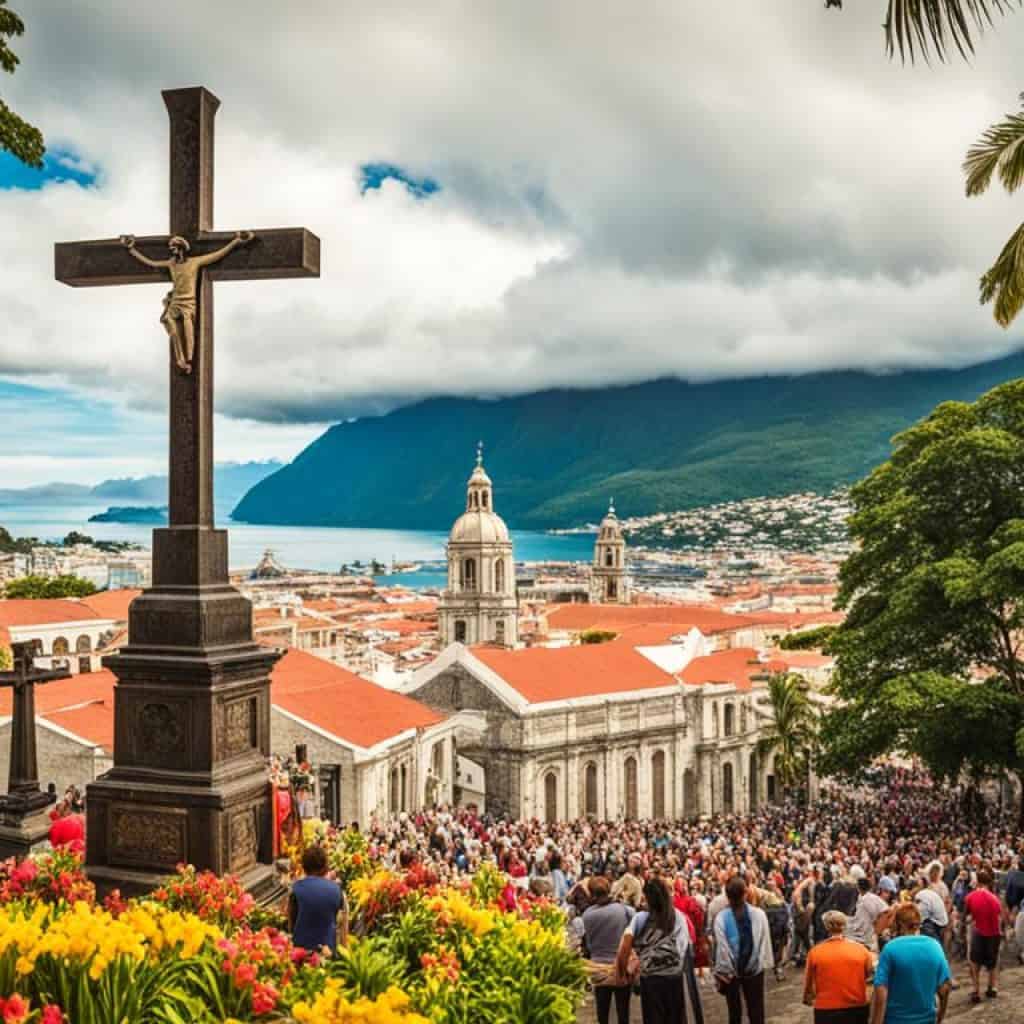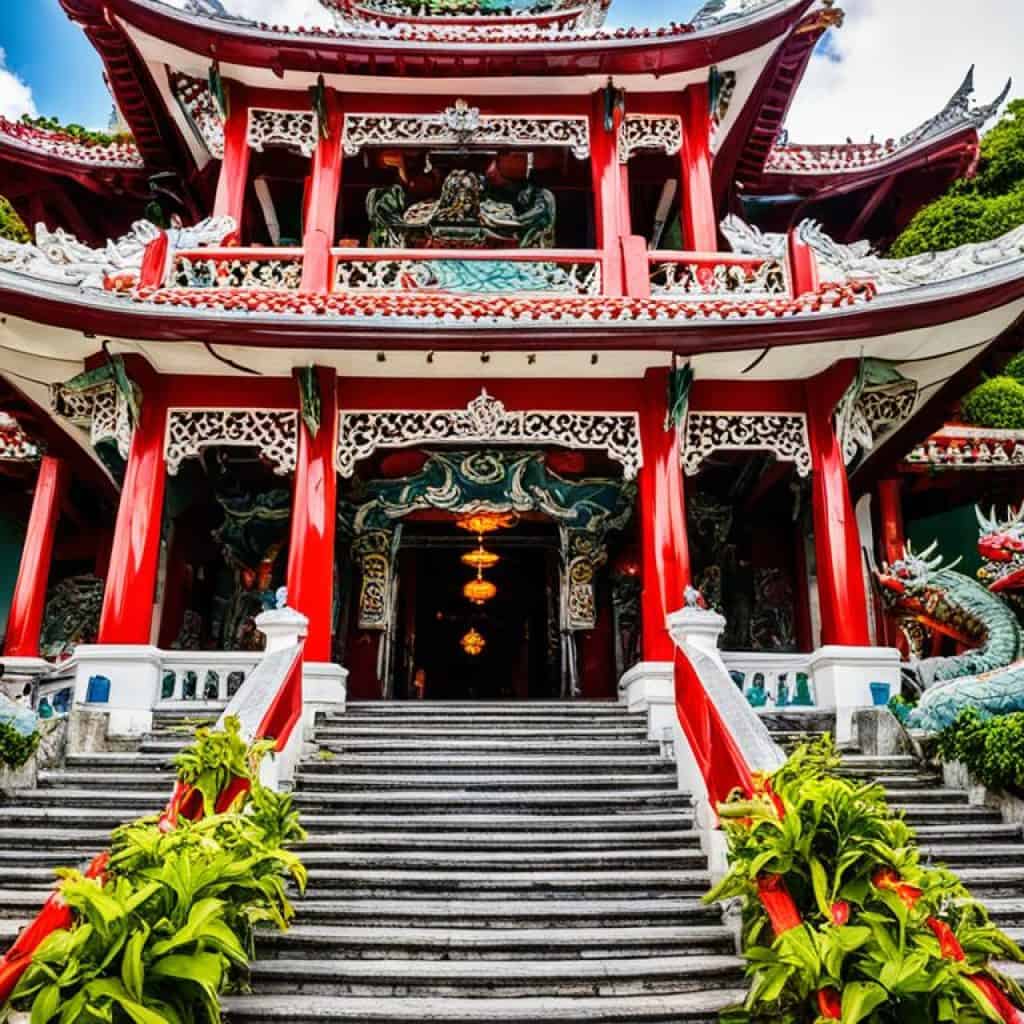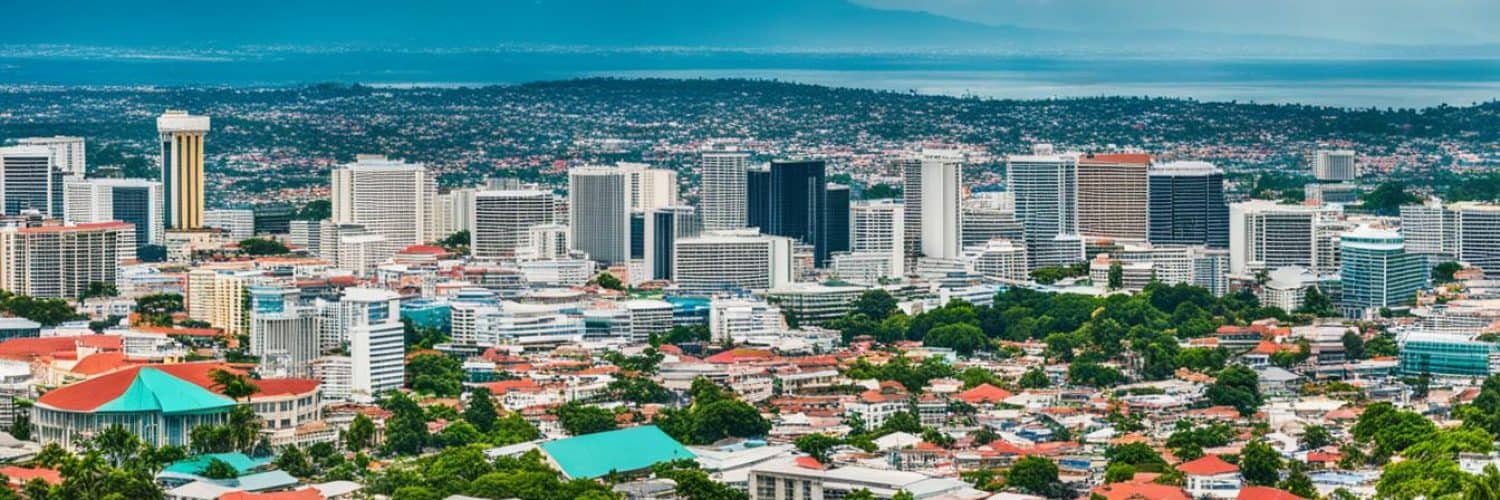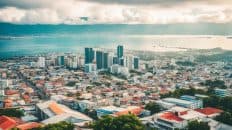Have you ever wondered why Cebu City is known as the “Queen City of the South?” What makes this destination so special that it has earned this prestigious title? Join us on a journey as we unveil the vibrant spirit, rich heritage, and captivating attractions that make Cebu City a top destination in the Philippines.
- Discover the historical landmarks that shaped the nation’s history, from Magellan’s Cross to the Basilica Minore del Santo Niño and Fort San Pedro.
- Immerse yourself in the economic landscape of Cebu City, a bustling hub of trade, business, and tourism.
- Indulge in the local cuisine and experience the cultural richness through festivals like the Sinulog Festival.
- Uncover the natural wonders of Cebu, from the breathtaking Kawasan Falls to the marine biodiversity of Moalboal and the awe-inspiring whale shark encounters in Oslob.
- Reflect on the challenges and opportunities that Cebu City faces, from rapid urbanization to sustainable development.
Are you ready to delve into the hidden treasures and vibrant charm of the Queen City of the South? Let’s embark on a journey that will leave you captivated and longing for more.
Key Takeaways:
- Cebu City, known as the “Queen City of the South,” offers a vibrant urban experience, rich history, and diverse cultural heritage.
- Explore historical landmarks such as Magellan’s Cross and Fort San Pedro that shaped the nation’s history.
- Experience the economic vitality of Cebu City as a hub of trade, business, and tourism.
- Indulge in the local cuisine and immerse yourself in the cultural richness of the city, highlighted by the Sinulog Festival.
- Discover the natural attractions of Cebu, including Kawasan Falls, Moalboal’s marine biodiversity, and Oslob’s whale shark encounters.
Historical Tapestry
Step into the rich tapestry of Cebu’s history, woven through the threads of time and the remnants of Spanish colonial rule. The arrival of Portuguese explorer Ferdinand Magellan in 1521 marked a pivotal moment, igniting a new era for the Philippines.
“Magellan’s landing in Cebu was a catalyst for change, setting the stage for Spanish influence and the enduring impact it had on this island city.”
Magellan’s Cross, an iconic symbol of this historical milestone, stands as a testament to the profound shift that occurred during that era. The cross, planted by Magellan and his companions upon their arrival, is a tangible reminder of Cebu’s colonial past and the Christianization of its people.
Beside Magellan’s Cross, the Basilica Minore del Santo Niño stands tall, a beacon of faith and a historical landmark. This grand church, the oldest Roman Catholic church in the country, enshrines the venerated image of the Santo Niño, a significant religious icon.
Rounding out the historical landmarks is Fort San Pedro, a stone fortress that harks back to a time of defense and strategic military planning. Originally built by Miguel López de Legazpi in the 16th century, it served as a stronghold against Muslim raiders and foreign invaders, solidifying Cebu’s position as a key stronghold within the Spanish colonial era.
Exploring Cebu’s Historical Landmarks:
| Landmark | Significance |
|---|---|
| Magellan’s Cross | Symbol of Spanish arrival and Christianization |
| Basilica Minore del Santo Niño | Oldest Roman Catholic church in the Philippines |
| Fort San Pedro | Historic military fortress from the Spanish colonial era |
These historical landmarks, woven into the fabric of Cebu’s past, offer a glimpse into the city’s captivating history. As you explore Cebu’s rich cultural tapestry, let the echoes of the Spanish colonial era guide you through time, unearthing stories and experiences that continue to shape the vibrant city we know today.
Economic Landscape
Cebu City has transformed into a thriving economic hub, positioning itself as a major trading and business center in the Visayas region. Its strategic location has attracted both local and international investments, propelling the city’s economic growth.
Key industries in Cebu, such as manufacturing, trade, and tourism, contribute significantly to the Philippines’ overall economic development. The city is home to prominent developments like the Cebu Business Park and Cebu IT Park, which have become catalysts for job creation and business opportunities.
The Cebu Business Park, a premier business district, houses multinational companies, local enterprises, and financial institutions. Its state-of-the-art infrastructure and proximity to commercial establishments make it an ideal location for corporations to establish their presence.
On the other hand, Cebu IT Park serves as a dedicated area for technology-driven industries, attracting globally recognized companies in the business process outsourcing (BPO) sector and technology startups. The park’s vibrant atmosphere and comprehensive support services bolster innovation and entrepreneurial activities.
This image showcases the bustling activity and dynamic nature of Cebu City as an economic hub.
Manufacturing, Trade, and Tourism
Cebu City’s manufacturing sector plays a vital role in the regional and national economy. It encompasses various industries, including electronics, furniture, food processing, and textiles. The city’s skilled workforce and well-established supply chains contribute to its competitiveness in the manufacturing industry.
Furthermore, Cebu City’s strategic location as a major trading hub makes it an ideal base for both domestic and international trade. Its well-developed seaport and airport infrastructure enable efficient movement of goods and services, facilitating trade linkages with other regions and countries.
Cebu City’s vibrant tourism industry also fuels its economic growth. The city attracts visitors from around the globe with its diverse array of attractions, from historical landmarks to natural wonders. The White Beaches of Mactan Island, the stunning Badian’s Kawasan Falls, and the captivating heritage sites within the city are among the top tourist destinations.
“Cebu City’s strategic location as a major trading and business center in the Visayas region has attracted local and international investments.”
Cebu City’s economic landscape is a testament to its resilience, innovation, and strategic positioning as an economic powerhouse in the Philippines. The city’s commitment to creating an environment conducive to various industries and its emphasis on sustainable development will ensure continued economic prosperity for years to come.
| Industries | Key Developments |
|---|---|
| Manufacturing | Cebu Business Park |
| Trade | Cebu IT Park |
| Tourism | White Beaches of Mactan Island |
Cultural Richness
Cebu City is a melting pot of cultures, reflecting a harmonious blend of indigenous traditions, Spanish influences, and contemporary expressions. This vibrant city offers a range of cultural experiences for visitors to immerse themselves in.
The Sinulog Festival
One of Cebu’s most anticipated events is the annual Sinulog Festival. Held every January, this grand celebration pays homage to the Santo Niño, a revered religious icon. The festival showcases lively street dancing, extravagant costumes, and vibrant performances that captivate both locals and tourists alike.
University of San Carlos Museum
To delve deeper into Cebu’s rich cultural heritage, a visit to the University of San Carlos Museum is a must. The museum houses a vast collection of artifacts and relics that provide insight into the city’s historical and artistic heritage. From ancient artifacts to religious art, visitors can explore Cebu’s diverse past through these captivating exhibits.
Gastronomic Delights
Cebu City is renowned for its culinary scene, offering a gastronomic adventure for food enthusiasts. One dish that has gained international acclaim is Cebu’s famous lechon, a succulent roasted pig with crispy skin and tender meat. Another culinary hotspot is Larsian sa Fuente, a bustling food market where you can savor a variety of local delicacies cooked in traditional Filipino style.
Exploring Cebu’s Culinary Scene
“Cebu’s culinary scene is a fusion of flavors and influences, creating a unique gastronomic experience. From street food stalls to upscale restaurants, there’s something to please every palate.”
Whether you’re dining at a local eatery or indulging in fine dining, Cebu City offers a diverse range of culinary delights that showcase the flavors and ingredients of the region.
| Must-Try Dishes | Recommended Dining Spots |
|---|---|
| Lechon – Roasted Pig | Larsian sa Fuente |
| Sisig – Sizzling Pork | |
| Tuslob Buwa – Pig’s Brain Sauce | Sugbo Mercado |
| Puso – Hanging Rice |
Whether you’re exploring the rich cultural heritage, participating in the Sinulog Festival, or indulging in mouthwatering dishes, Cebu City’s cultural richness is sure to leave an indelible mark on your travel experience.
Natural Attractions
When it comes to natural beauty, Cebu is a hidden paradise waiting to be discovered. From breathtaking waterfalls to mesmerizing marine life, there’s something for every nature lover and adventure seeker.
Badian’s Kawasan Falls
One of the top highlights in Cebu is Badian’s Kawasan Falls. With its cascading turquoise water and lush surroundings, it provides a picturesque backdrop for relaxation and adventure. Whether you want to take a refreshing dip in the cool waters or go canyoneering through the nearby canyons, this natural wonder is a must-visit.
Moalboal and Pescador Island
For those who love the underwater world, Moalboal is a dream destination. Its pristine beaches and vibrant coral reefs make it a popular spot for diving and snorkeling enthusiasts. Don’t miss the chance to explore Pescador Island, known for its rich marine biodiversity and breathtaking underwater landscapes.
Oslob and Whale Shark Watching
Oslob has gained international recognition for its incredible whale shark watching activities. Here, you can have a once-in-a-lifetime experience of swimming alongside these gentle giants in their natural habitat. Witnessing the beauty and grace of whale sharks up close is an unforgettable experience that will leave you in awe of nature’s wonders.
Embark on an adventure to Badian’s Kawasan Falls, explore the underwater paradise of Moalboal and Pescador Island, and dive into the world of whale sharks in Oslob. Cebu’s natural attractions will leave you spellbound, creating memories that will last a lifetime.
Challenges and Opportunities
As Cebu City experiences rapid urbanization and growth, it faces a range of challenges and opportunities. One significant challenge is the increasing issue of traffic congestion due to the influx of people and vehicles. The city’s infrastructure is struggling to keep up with the demands, resulting in daily gridlocks that impact both residents and businesses.
Another pressing concern is waste management. With the rise in population and economic activities, the amount of waste generated has also increased. Effective waste management practices are crucial to maintain a clean and sustainable environment for the city and its residents.
To overcome these challenges, Cebu City needs to focus on sustainable development. This involves implementing urban planning strategies that prioritize efficient transportation systems, waste reduction and recycling programs, and the preservation of natural resources.
“Sustainable development is the pathway to the future that we want for all. It offers a framework to generate economic growth, achieve social justice, exercise environmental stewardship, and strengthen governance.” – Ban Ki-moon
Beyond the environmental aspects, Cebu City also faces economic challenges such as unemployment and income inequality. While the city has experienced overall economic growth, it is essential to ensure that the benefits are distributed equitably among all sectors of society.
Addressing these economic challenges requires a multi-faceted approach. By investing in education and skills training programs, Cebu can empower its workforce and reduce unemployment. Implementing policies that promote inclusive growth and mitigate income inequality will help create a more prosperous and harmonious community.
Potential Solutions:
To effectively address these challenges, Cebu City can consider the following solutions:
- Implement integrated and efficient public transportation systems to reduce traffic congestion and promote sustainable mobility.
- Develop comprehensive waste management strategies, including recycling programs and awareness campaigns to educate residents about the importance of proper waste disposal.
- Encourage sustainable development practices by incorporating green building standards and promoting renewable energy sources.
- Invest in skills training and job creation programs to reduce unemployment rates and promote economic opportunities for all segments of the population.
- Implement policies and initiatives that promote income equality, such as social welfare programs and equitable distribution of resources.
By addressing these challenges and seizing the opportunities for sustainable development, Cebu City can pave the way for a prosperous and inclusive future for its residents.
Comparison of Traffic Congestion and Waste Management in Cebu City:
| Challenges | Traffic Congestion | Waste Management |
|---|---|---|
| Causes | Rapid urbanization and increasing population | Rising amount of waste generated |
| Impact | Delays in commuting, decreased productivity | Pollution, health hazards |
| Solutions | Improved public transportation, traffic management systems | Recycling programs, waste segregation, education campaigns |
| Benefits | Reduced congestion, improved quality of life | Cleaner environment, sustainable practices |
Future Outlook
Cebu City’s future is dependent on its commitment to sustainable practices, cultural heritage preservation, and adaptation to the changing global landscape. With strategic investments in infrastructure, technology, and education, Cebu can emerge as a regional economic powerhouse. The city’s leadership has a crucial role in steering Cebu towards a future that prioritizes progress and the well-being of its residents.
One of the key factors in ensuring a prosperous future for Cebu City is the implementation of sustainable practices. By integrating eco-friendly initiatives and promoting responsible resource management, Cebu can minimize its environmental impact while still fostering economic growth.
“Preserving cultural heritage is also of utmost importance. Cebu City is known for its rich history and diverse cultural traditions. By safeguarding historical landmarks, promoting local arts and crafts, and preserving traditional practices, Cebu can maintain its unique identity and attract visitors interested in experiencing its rich cultural heritage.”
Infrastructure investments are critical to the city’s future. By upgrading transportation systems, improving connectivity, and enhancing public spaces, Cebu City can optimize its potential as a trade and tourism hub. State-of-the-art infrastructure will attract more businesses, investors, and visitors, boosting the city’s economy.
As Cebu City continues to grow as a major player in trade and tourism, it must assume a leadership role in these industries. By fostering innovation, promoting collaboration, and adapting to emerging trends, Cebu can position itself as a leading destination for international trade and tourism. By taking the lead in these sectors, Cebu City can drive economic growth and create more opportunities for its residents.
Celebrating Progress While Preserving Cultural Heritage
Cebu City’s future success lies in striking a balance between economic growth and preserving its cultural heritage. The city can achieve this by embracing sustainable practices, investing in infrastructure, and taking a leadership role in trade and tourism. By doing so, Cebu City can continue to captivate visitors from around the world, while also preserving the essence of its vibrant and diverse culture.
Fort San Pedro
Fort San Pedro is a historical landmark in Cebu City, dating back to the Spanish colonial era. Built by Miguel López de Legazpi in the 16th century, it served as a military defense structure against Muslim raiders and other foreign invaders. The triangular fort is the oldest fort in the Americas and a testament to Cebu’s rich history.
Constructed on the site where the Spanish forces, led by Legazpi, first landed in Cebu in 1565, Fort San Pedro played a strategic role in protecting the region from attacks. Its location near the sea provided a vantage point for surveillance and defense. The fort features thick stone walls, bastions, and a watchtower that overlooks the surrounding area.
“Fort San Pedro stands as a monumental reminder of Cebu’s storied past, offering visitors a glimpse into the city’s role during the Spanish colonial period.” – Local Historian
Today, the fort has been transformed into a museum that showcases artifacts, exhibits, and historical information about Cebu’s colonial era. Visitors can explore the inner chambers, walk along the ramparts, and admire the cannons that once defended the fort. The museum provides a fascinating insight into Cebu’s military history and its significance as a strategic stronghold.
Additionally, Fort San Pedro’s picturesque surroundings and beautiful gardens make it an ideal spot for leisurely walks and relaxation. The well-maintained grounds offer a tranquil escape from the bustling city, allowing visitors to soak in the ambiance of the fort and its historical significance.
Historical Significance
Fort San Pedro played a pivotal role in Cebu’s history, serving not only as a defensive structure but also as a symbol of Spanish colonial power and influence. Its strategic location, overlooking the sea and neighboring areas, allowed the Spanish forces to maintain control over the region and protect their interests in the Philippines.
The fort’s existence is a testament to the enduring legacy of the Spanish colonial era and the enduring impact it has had on Cebu’s cultural and historical development. Fort San Pedro stands as a reminder of the city’s resilience and the rich tapestry of its past.
| Key Details | Fort San Pedro |
|---|---|
| Location | Cebu City, Philippines |
| Construction | 1565 |
| Architect | Miguel López de Legazpi |
| Architecture Style | Spanish Colonial |
| Current Status | Museum |
| Opening Hours | 8:00 AM – 6:00 PM |
Magellan’s Cross & Basilica del Santo Niño
One cannot talk about the historical and religious significance of Cebu City without mentioning Magellan’s Cross and the Basilica del Santo Niño. These iconic landmarks hold a special place in the city’s cultural heritage, showcasing its rich history and deep-rooted religious devotion.
Magellan’s Cross, planted in 1521 by Portuguese and Spanish explorers upon their arrival in Cebu, stands as a symbol of Cebu’s colonial past. This wooden cross represents the first Christianization of the Philippines, marking Magellan’s landing and the introduction of Christianity to the archipelago. Visitors from all over the world come to witness this historical artifact and pay homage to its religious significance.
The Basilica del Santo Niño, located nearby, is the oldest Roman Catholic church in the country. Built in 1565, it houses the image of the Santo Niño (Child Jesus), which was given as a gift to Queen Juana of Cebu by Magellan. The basilica holds great religious importance and is a destination for many devout Catholics, particularly during the Sinulog Festival, when pilgrims come to offer their prayers and seek blessings.
“Magellan’s Cross and the Basilica del Santo Niño encapsulate Cebu’s historical and religious journey, serving as reminders of its colonial heritage and deep-rooted faith.”
Cebu City takes pride in preserving these historical landmarks and showcasing them to locals and tourists alike. They serve as testaments to Cebu’s past and the enduring Christian faith that shaped the city’s cultural identity.

Both Magellan’s Cross and the Basilica del Santo Niño stand as beacons of historical significance and religious devotion, attracting visitors from all walks of life. These landmarks reinforce the remarkable history of Cebu City and its enduring Christian heritage.
Sushi Sake
If you’re in the mood for authentic Japanese cuisine during your stay in Cebu City, look no further than Sushi Sake. Located in the prestigious Radisson Blu Cebu, this restaurant offers a delightful culinary experience infused with the flavors of Japan.
The menu at Sushi Sake boasts a wide selection of traditional Japanese dishes, including exquisite maki rolls and fresh sashimi. Their skilled chefs craft each plate with precision and artistry, ensuring that every bite is a true delight for the senses.
Whether you’re a sushi aficionado or simply looking to explore the world of Japanese cuisine, Sushi Sake is a must-try restaurant in Cebu City. The combination of impeccable service, serene ambiance, and delectable flavors will leave you yearning for more.
The Sushi Sake Experience
At Sushi Sake, each dish is crafted with the utmost care and attention to detail. The expert sushi chefs use only the freshest ingredients to create a symphony of flavors that will transport you straight to Japan.
“The maki rolls at Sushi Sake are a true work of art. Each roll is meticulously prepared, combining different textures and flavors to create a harmonious and satisfying culinary experience.” – Food Critic
Whether you prefer classic favorites like California rolls and spicy tuna rolls or adventurous creations like dragon rolls and rainbow rolls, Sushi Sake has something to satisfy every palate.
A True Culinary Destination in Radisson Blu Cebu
Situated within the renowned Radisson Blu Cebu, Sushi Sake encapsulates the essence of Japanese cuisine in a setting of elegance and sophistication. The restaurant’s chic and modern design creates the perfect backdrop for an exquisite dining experience.
Whether you’re a guest at the hotel or a local resident exploring the culinary scene, make sure to reserve a table at Sushi Sake. Indulge in an unforgettable journey through the flavors of Japan, right in the heart of Cebu City.
Feria
Located within the renowned Radisson Blu Cebu, Feria stands as the signature buffet restaurant, offering a feast for the senses. As a premier buffet restaurant in Cebu City, Feria is known for its exquisitely prepared and diverse spread of international cuisines.
At Feria, guests can embark on a culinary journey, exploring a wide selection of dishes inspired by different cultures around the world. From Asian delicacies to European classics, the buffet showcases a symphony of flavors that cater to every palate.
The ambiance at Feria is warm and inviting, creating an atmosphere perfect for intimate gatherings, family celebrations, or business lunches. The restaurant’s elegant design and sophisticated decor add a touch of charm to the dining experience.
One of the highlights of dining at Feria is the witty puns displayed next to the food, adding a delightful sense of humor to the dining experience. It not only satisfies the taste buds but also sparks joy and creates a memorable dining experience for guests.
“Feria’s buffet is a delightful culinary journey that offers a wide array of international cuisines under one roof. From the moment you step inside, you are greeted with an enticing display of delectable dishes that are prepared with utmost care and passion.”
– A satisfied guest
Whether you’re a guest at Radisson Blu Cebu or simply a food enthusiast exploring Cebu City, a visit to Feria is a must. The restaurant promises a gastronomic adventure that will leave you craving for more.
| Cuisine | Highlights |
|---|---|
| Asian | Sushi, dim sum, stir-fried noodles, curry |
| European | Pasta, roasted meats, cheese platter |
| American | Burgers, barbecue, mac and cheese |
| Mediterranean | Grilled seafood, hummus, tabbouleh |
| Local | Cebu lechon, kinilaw, adobo |
Radisson Blu Cebu
Experience luxury and sophistication at Radisson Blu Cebu, a prestigious 5-star hotel situated in the heart of vibrant Cebu City. Boasting a strategic location, this exquisite hotel provides convenient access to historical sites, cultural landmarks, and a myriad of leisure destinations.
At Radisson Blu Cebu, guests are treated to an unparalleled experience featuring top-notch amenities and world-class service. The hotel offers a state-of-the-art swimming pool, perfect for a refreshing dip or sunbathing in style. Stay active and maintain your fitness routine at our fully equipped gym, designed to meet the needs of health-conscious travelers.
The rooms at Radisson Blu Cebu are meticulously designed with your comfort in mind. Each room combines elegant decor with modern amenities, inviting you to relax and unwind after a day of exploring the enchanting Queen City of the South. Whether you are visiting for business or leisure, Radisson Blu Cebu ensures a luxurious stay that exceeds your expectations.
“Radisson Blu Cebu is the epitome of luxury and sophistication. From the moment you step into the grand lobby, you are greeted with impeccable service and a warm ambiance that envelops you throughout your stay.”
– Review from a satisfied guest
Strategic Location for Exploration
Radisson Blu Cebu’s central location makes it the ideal starting point for your Cebu City adventure. Immerse yourself in the historical charm of Magellan’s Cross and the Basilica del Santo Niño, both just a stone’s throw away from the hotel. Wander through the vibrant streets lined with shops, restaurants, and historical landmarks, capturing the essence of Cebu’s rich cultural heritage.
Savor Culinary Delights
Indulge in a gastronomic journey at the hotel’s exquisite restaurants and bars, offering an array of international flavors and local delicacies. From delectable sushi at Sushi Sake to the extensive buffet spread at Feria, Radisson Blu Cebu caters to every palate with its exceptional culinary offerings.
Unforgettable Events and Facilities
With its spacious event venues and state-of-the-art facilities, Radisson Blu Cebu is the perfect choice for hosting memorable gatherings, conferences, and weddings. Our dedicated event planners are committed to making your special occasion a resounding success, leaving you with cherished memories that will last a lifetime.
| Amenities | Facilities |
|---|---|
| * Luxurious swimming pool | * Spacious event venues |
| * Fully equipped gym | * State-of-the-art conference rooms |
| * Elegant spa and wellness center | * Dedicated wedding planning services |
Experience perfection at Radisson Blu Cebu, where luxury meets convenience and exceptional service awaits. Book your stay today and embark on a journey of unparalleled opulence in the heart of the Queen City of the South.
Cebu Taoist Temple
The Cebu Taoist Temple, a magnificent Chinese temple, is a historical attraction that showcases the rich cultural heritage of the local Chinese community in Cebu City. Perched on a hilltop, this architectural masterpiece offers breathtaking views of the cityscape below.

The temple’s intricate dragon statues and ornate architecture are a testament to the ancient Chinese traditions and beliefs. As visitors step inside, they are transported to a serene and peaceful environment, away from the hustle and bustle of the city.
“The Cebu Taoist Temple is a hidden gem that mesmerizes visitors with its mesmerizing beauty and spiritual ambiance.” – Traveler’s Guide
The temple complex features various prayer halls, gardens, and meditation areas where visitors can immerse themselves in the spirituality of the place. It serves as a gateway for anyone interested in exploring and appreciating Chinese culture and traditions.
- Experience the calmness and serenity of the temple’s surroundings
- Marvel at the intricate dragon sculptures and detailed artwork
- Explore the various prayer halls and meditation areas
- Learn about the customs and rituals of Taoism
Whether you have a deep interest in Chinese culture or simply seek tranquility in a serene setting, the Cebu Taoist Temple is a must-visit historical attraction that will leave you awe-inspired and spiritually uplifted.
Tops Lookout
When it comes to breathtaking views of Cebu City, Tops Lookout is the place to be. Located on a hilltop, this hidden gem offers a mesmerizing viewpoint that showcases the scenic beauty of Mandaue, Cebu City itself, Mactan Island, and even the enchanting Bohol coast. Whether you visit Tops Lookout in the early morning or during sunset, you’ll be treated to panoramic vistas that will leave you in awe.
With its elevated position, Tops Lookout provides visitors with an immersive experience of Cebu’s stunning natural landscapes. Witness the city awaken with the first rays of sunlight or marvel at the vibrant hues painting the sky as the sun bids farewell. These captivating sunrise and sunset views from Tops Lookout make it an absolute must-visit destination for anyone seeking sublime beauty and serenity.
Conclusion
Cebu City, also known as the Queen City of the South, is a vibrant and diverse destination that has something to offer every visitor. With its rich historical landmarks, bustling economic landscape, cultural richness, and natural attractions, Cebu City exemplifies the spirit and charm of the Philippines.
From the iconic Magellan’s Cross and the historic Fort San Pedro to the colorful Sinulog Festival and mouthwatering local cuisine, Cebu City showcases its vibrant past and present. The city’s economic growth and development make it a prime location for trade and tourism, attracting both local and international investments.
As Cebu City continues to evolve, its future lies in embracing sustainable practices and preserving its cultural heritage. By striking a balance between progress and tradition, Cebu City is poised to take a leadership role in the region. Its undeniable resilience, creativity, and vibrant spirit make Cebu City a must-visit destination for both locals and travelers from around the world.


















Add comment